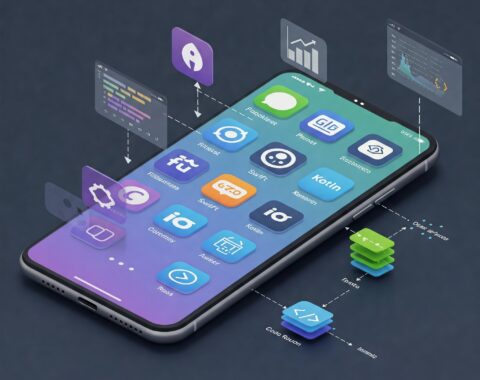User experience (UX) and user interface (UI) design are critical in determining the success of mobile applications. With the rapid evolution of technology, designers must stay ahead of emerging trends to craft intuitive, engaging, and aesthetically appealing applications. A well-structured UI with smooth navigation enhances user experience, making an app more attractive and user-friendly. Given the intense competition on Google Play and the Apple App Store, integrating innovative UI/UX design trends is essential for apps to stand out.
Appbirds Technologies highlights the top UI/UX design trends revolutionizing mobile app development.
1. Neumorphism: The Next Evolution of Skeuomorphism
The Next-Level Skeuomorphism Neumorphism is a modern take on skeuomorphism, blending flat design with real-world elements. It creates soft, minimalist interfaces with subtle shadows and highlights, giving buttons and cards a raised, almost 3D-like effect. This trend enhances user interactions by making elements look tactile and interactive while maintaining a modern aesthetic. The result is a sleek and engaging UI that feels intuitive and immersive.
2. Dark Mode & Adaptive UI
Dark mode is no longer just a trend—it’s necessary for many users. With an increasing preference for darker themes, dark mode helps reduce eye strain, enhances readability, and improves battery efficiency on OLED screens. Adaptive UI goes a step further by allowing seamless transitions between light and dark modes based on user preferences or system settings, ensuring an optimized experience for every user.
3. Typography-Centric UI Design
Typography plays a crucial role in UI/UX design by enhancing readability, setting a visual hierarchy, and reinforcing brand identity. Clean and well-structured typography improves user engagement and makes information easier to digest. Bold headlines, minimalist font choices, and dynamic text layouts help create a more modern and accessible interface that aligns with the latest design aesthetics.
4. Voice User Interface (VUI) & Gesture-Based Navigation
Voice User Interface (VUI) & Gesture Control With the advancement of AI and voice recognition technology, voice-enabled interactions are becoming more common in mobile apps. Integrating VUI allows users to navigate apps hands-free, improving accessibility and creating a more natural interaction experience. Gesture-based navigation, such as swipes, taps, and pinches, further enhances usability by making interactions more fluid and intuitive, reducing reliance on traditional buttons.
5. Augmented Reality (AR) for Immersive Experiences
AR is rapidly becoming mainstream, with mobile applications integrating immersive experiences for shopping, gaming, and education. AR-based UI/UX designs provide interactive product visualization, real-world simulations, and engaging learning experiences. Whether it’s trying on virtual clothes, visualizing furniture in a room, or experiencing an interactive game world, AR brings a new level of engagement to mobile applications.
6. Microinteractions for Improved Engagement
Microinteractions, such as subtle animations, button hovers, and responsive feedback, significantly improve user engagement and provide intuitive navigation. These small yet powerful details make the user experience feel more dynamic and engaging without overwhelming the user. By adding delightful interactions, such as a subtle bounce when a button is pressed or a smooth transition between screens, apps become more enjoyable to use.
7. 3D Graphics & Illustrations
The use of 3D elements in mobile UI is gaining traction, enhancing depth, realism, and overall aesthetics. High-quality 3D icons, illustrations, and animations make applications visually appealing and engaging for users. When implemented correctly, 3D graphics can make interfaces feel more interactive, immersive, and sophisticated, elevating the overall design experience.
8. Personalization & AI-Driven UI
AI-driven personalization tailors content, recommendations, and interface elements based on user behavior and preferences. Smart UX design adapts dynamically to provide a more customized experience, improving user satisfaction and retention. From personalized content feeds to AI-driven chatbots that assist users, intelligent UX enhances engagement and interaction.
9. Super Apps & Integrated Ecosystems
Super apps consolidate multiple services into a single platform, offering users a seamless, one-stop experience. By integrating various functionalities, such as payments, messaging, shopping, and entertainment, super apps simplify user journeys and improve convenience. With an intuitive UI, users can navigate through different services effortlessly, enhancing engagement and retention.
10. Accessibility-First Design
Inclusivity is a key priority in modern UI/UX design. Mobile applications are integrating accessibility features such as voice commands, adjustable font sizes, color contrast settings, and haptic feedback to cater to diverse user needs. Designing for accessibility ensures usability for everyone, including individuals with disabilities, improving overall app adoption and user satisfaction.
11. Motion Design & Animated UI Elements
Motion design is becoming a fundamental part of UI/UX, making interfaces more dynamic and interactive. Smooth animations, transitions, and micro-interactions enhance the visual appeal of apps while guiding users through the interface intuitively. Whether it’s animated loading screens or fluid button transitions, motion design improves usability and engagement.
12. Minimalist & Content-Focused Design
Minimalism continues to evolve, focusing on content clarity and usability. Clean layouts, simple navigation, and an emphasis on essential features help eliminate distractions, improving the overall user experience. By using negative space effectively, minimalist design ensures users can easily access what they need without unnecessary complexity.
13. Blockchain & Secure UX Design
With growing concerns about data security and privacy, blockchain-based UI/UX is gaining traction. Decentralized authentication, secure transactions, and transparent data handling ensure trust and security for users. As data breaches become more common, implementing secure UX design principles helps build user confidence and brand credibility.
14. Location-Based UX & Cross-Platform Consistency
Location-aware mobile apps provide real-time, personalized content and notifications, enhancing user experiences in industries such as food delivery, ride-sharing, and event planning. Additionally, ensuring a consistent UX across multiple platforms—including smartphones, tablets, and desktops—is crucial for retaining users and maintaining brand identity.
15. Data Visualization for Better Insights
Location-aware mobile apps provide real-time, personalized content and notifications, enhancing user experiences in industries such as food delivery, ride-sharing, and event planning. Additionally, ensuring a consistent UX across multiple platforms—including smartphones, tablets, and desktops—is crucial for retaining users and maintaining brand identity.
Best Practices for Implementing UI/UX Trends in Mobile Apps
To successfully incorporate these trends, mobile app developers should adhere to the following best practices:
User-Centric Design – Prioritize intuitive navigation and usability.
Extensive Usability Testing – Conduct A/B tests and gather feedback for improvements.
Consistency Across Platforms – Maintain uniform UX across mobile, tablet, and web interfaces.
Adaptability & Innovation – Continuously refine UI/UX based on real-time user behavior and preferences.
Conclusion
As mobile app development evolves, UI/UX design trends play a crucial role in enhancing user engagement and satisfaction. Appbirds Technologies stays ahead of the curve by incorporating these innovative design principles into mobile applications, ensuring a seamless, immersive, and personalized user experience.
By leveraging these trends, businesses can create apps that stand out in a competitive market while delivering top-notch user experiences. Stay ahead with cutting-edge UI/UX designs and transform your mobile app’s success!
Get in Touch
At Appbirds Technologies, we specialize in state-of-the-art UI/UX design services that elevate mobile app experiences. Whether it’s AI-powered personalization, AR integration, or secure blockchain-based UX, our expert designers can bring your app vision to life.
Contact us today to connect with expert UI/UX designers and transform your mobile app’s success!



